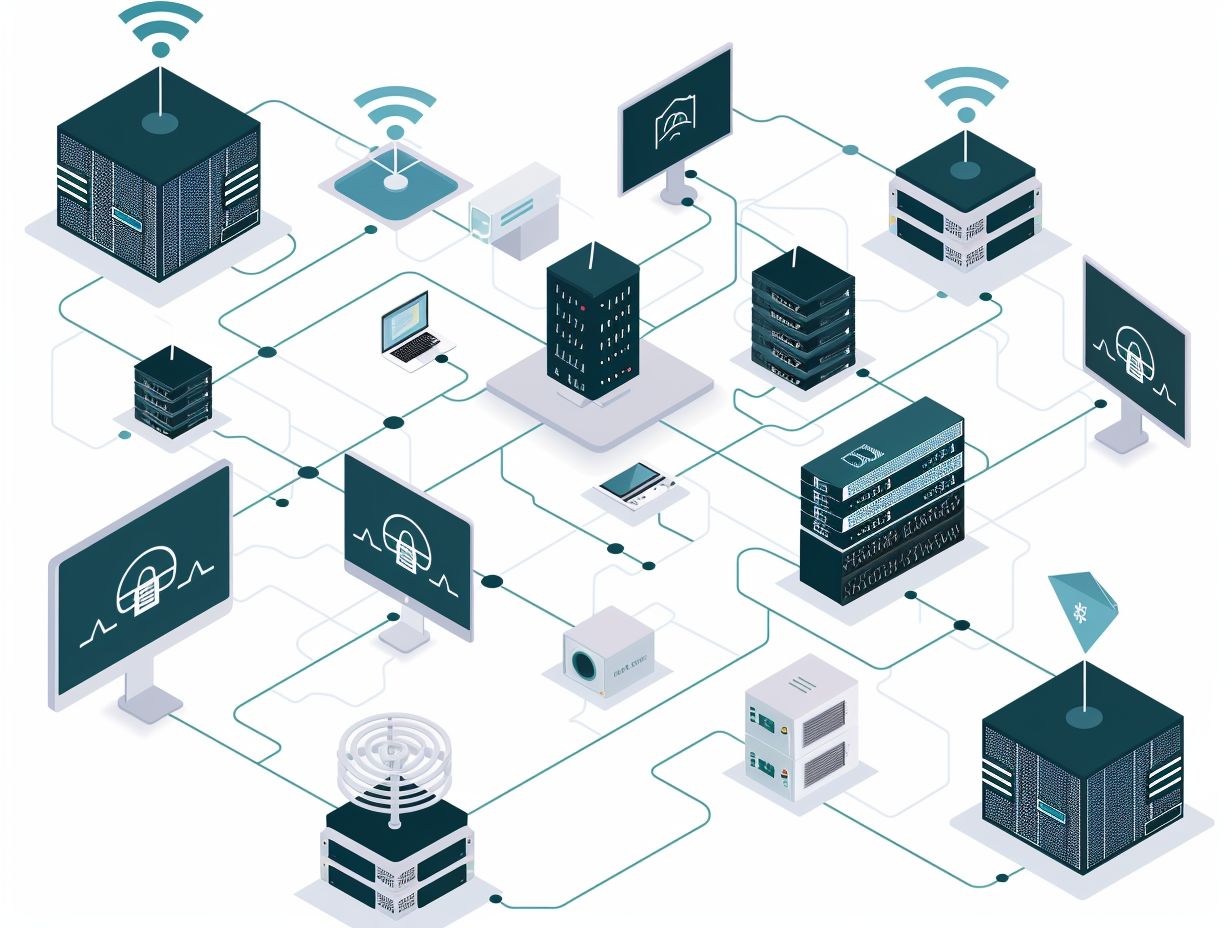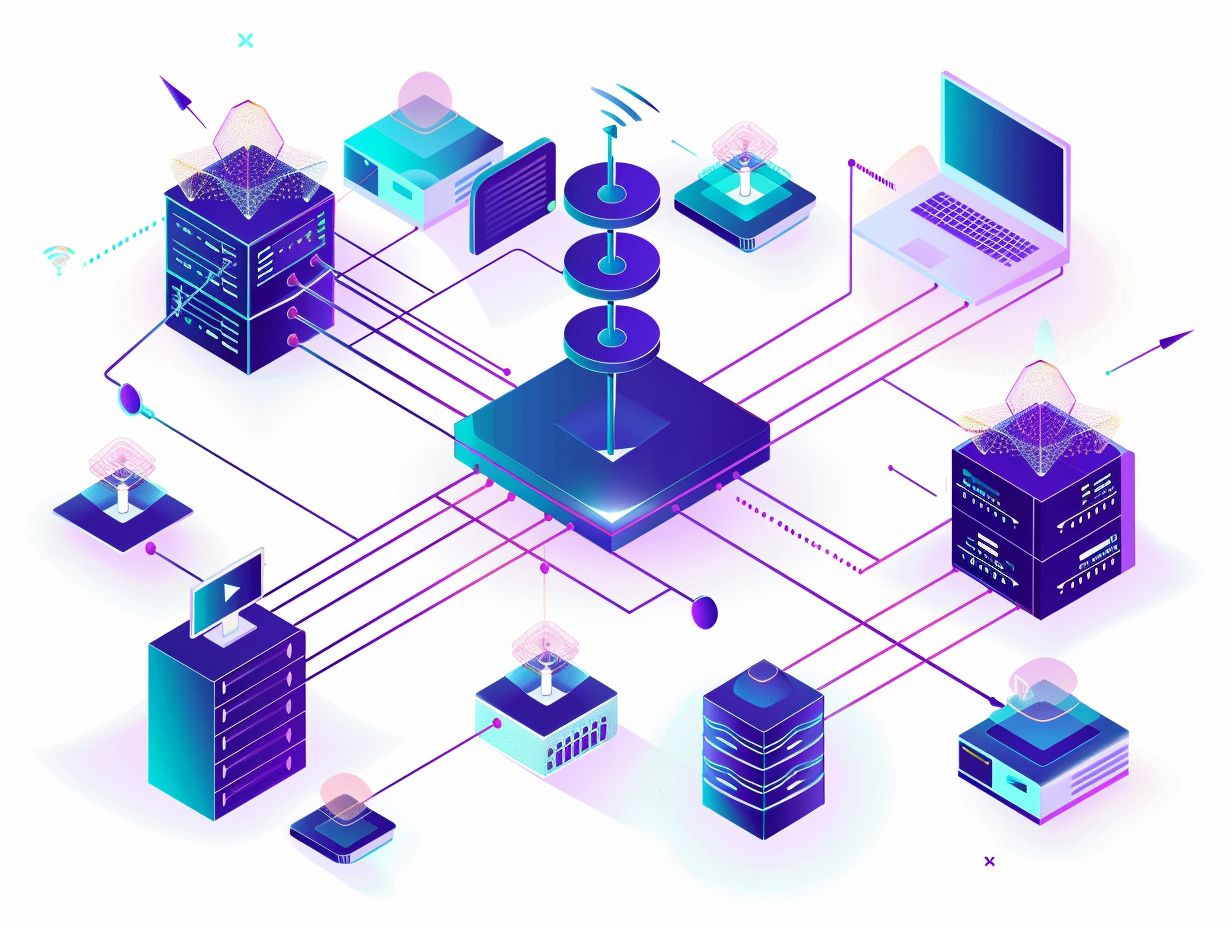In the ever-evolving landscape of technology, the transition from IPv4 to IPv6 is becoming increasingly crucial for enterprise networks. Understanding the key differences and similarities between these two protocols is essential for IT professionals like yourself to navigate this shift successfully. This article explores the limitations of IPv4 and the advantages of IPv6, along with strategies for preparing for and implementing the transition. Common challenges will be addressed, and best practices for maintaining secure and efficient IPv6 networks will be provided.
Key Takeaways:

- Transitioning from IPv4 to IPv6 is crucial for enterprises to keep up with the growing demand for IP addresses and to enable new technologies.
- Successful implementation of IPv6 requires careful planning, assessment of network infrastructure, and training for IT staff.
- Challenges such as compatibility issues and lack of support can be addressed through proper strategies and best practices for maintaining IPv6 networks.
Understanding IPv4 and IPv6
Understanding IPv4 and IPv6 is essential for the operation of modern networks. IPv4 and IPv6 are foundational technologies that dictate how devices communicate on the Internet, assigning unique addresses to each network-connected device. IPv4 has been the standard since the early days of the Internet, utilizing a 32-bit address structure that allows for approximately 4.3 billion unique addresses. In contrast, IPv6 employs a 128-bit address structure, providing an exponentially larger number of unique addresses to accommodate the increasing number of Internet-connected devices. Address assignment in IPv4 can occur dynamically through DHCP (Dynamic Host Configuration Protocol) or statically, while in IPv6, addresses can be automatically assigned using SLAAC (Stateless Address Autoconfiguration) or manually configured. These methods of address allocation are vital in ensuring efficient and reliable communication within networks, underscoring the importance of IPv4 and IPv6 for organizations and network infrastructure.
Key Differences and Similarities
When comparing IPv4 and IPv6, one of the key differences lies in the address format used by each protocol. IPv4 utilizes 32-bit addresses, while IPv6 uses 128-bit addresses, allowing for a vastly increased address space. This difference in address format directly impacts the number of available unique addresses. For example, IPv4 provides approximately 4.3 billion addresses, which are quickly exhausting due to the exponential growth of internet-connected devices. On the other hand, IPv6 offers an astronomically higher number of addresses, around 340 undecillion. Another distinction is seen in the way these protocols handle packet headers. IPv4 headers are fixed at 20 bytes, whereas IPv6 headers are at least 40 bytes due to the added complexity for features such as flow labeling and optional extension headers.
Why Transition to IPv6?
Transitioning to IPv6 is essential for you due to the limitations of IPv4 and the rising demand for additional IP addresses driven by the increasing number of devices and applications connecting to the Internet. One of the primary constraints of IPv4 is its address space, which permits only about 4.3 billion unique addresses. As the number of online devices continues to grow exponentially, this limited address pool is rapidly being exhausted. In contrast, IPv6 provides an extensive address space capable of accommodating nearly an unlimited number of unique IP addresses, effectively future-proofing the Internet. IPv6 also introduces improved security features, enhanced quality of service, and simplified network management, making it an optimal choice for organizations seeking to enhance their networks during the age of digital transformation.
Limitations of IPv4 and Advantages of IPv6
The limitations of IPv4, such as address space exhaustion and security vulnerabilities, emphasize the necessity of transitioning to IPv6 in order to benefit from enhanced security features and a significantly larger pool of available addresses. IPv4’s finite address space, which consists of 32-bit addresses, has made it increasingly difficult to provide unique addresses to the growing number of Internet-connected devices. To overcome this challenge, Network Address Translation (NAT) has been developed to extend the usability of IPv4 addresses. Furthermore, the absence of built-in security features in IPv4’s design renders it more vulnerable to cyber threats and attacks. In contrast, the 128-bit address structure of IPv6 offers an immensely larger address pool, capable of accommodating an almost infinite number of unique addresses to support the expanding network. Moreover, IPv6 incorporates integrated security protocols like IPsec, which enhance data confidentiality and integrity, addressing the security deficiencies present in IPv4.
Preparing for the Transition
 In preparing for the transition from IPv4 to IPv6, you need to assess your current network infrastructure, ensure effective management of the migration process, and provide comprehensive training for your IT teams to handle the switch seamlessly. One crucial step in this transition process is evaluating the compatibility of your current hardware and software with IPv6. It is important for organizations to identify any outdated equipment or systems that may not support the new protocol. Implementing robust management strategies, such as creating a detailed migration plan with milestones and checkpoints, is essential for tracking progress and addressing any challenges that may arise. Equally important is investing in ongoing training programs for your IT personnel to equip them with the necessary skills to troubleshoot issues and optimize network performance post-migration.
In preparing for the transition from IPv4 to IPv6, you need to assess your current network infrastructure, ensure effective management of the migration process, and provide comprehensive training for your IT teams to handle the switch seamlessly. One crucial step in this transition process is evaluating the compatibility of your current hardware and software with IPv6. It is important for organizations to identify any outdated equipment or systems that may not support the new protocol. Implementing robust management strategies, such as creating a detailed migration plan with milestones and checkpoints, is essential for tracking progress and addressing any challenges that may arise. Equally important is investing in ongoing training programs for your IT personnel to equip them with the necessary skills to troubleshoot issues and optimize network performance post-migration.
Assessing Network Infrastructure and Devices
Assessing your network infrastructure and devices is a critical initial step in the IPv6 transition process. This involves identifying compatibility issues, addressing hardware limitations, and ensuring the seamless integration of IPv6 protocols. One of the main challenges you may encounter when assessing network infrastructure for IPv6 compatibility lies in the potential lack of support for newer protocols and addressing schemes. Upgrading hardware components becomes imperative to meet the requirements of IPv6, as older devices may not have the necessary capabilities. It is crucial for you to conduct thorough compatibility checks and tests to pinpoint areas that need attention. By leveraging tools and resources designed for IPv6 migration, organizations can effectively navigate these challenges and implement the necessary upgrades to ensure a smooth transition.
Training and Education for IT Staff
Training and education for your IT staff are crucial factors in a successful IPv6 transition strategy. Equipping your IT teams with the necessary knowledge and skills is vital for ensuring a seamless migration to IPv6 and the effective management of network services. By offering specialized training services and resources, your organization can enable your IT teams to confidently navigate the complexities of IPv6 protocols and adhere to best practices. With a comprehensive understanding of IPv6, your IT staff can optimize network performance, strengthen security measures, and efficiently address any potential issues. Continuous education and upskilling in IPv6 technologies allow your IT professionals to stay abreast of developments in the ever-evolving digital landscape, ensuring that your organization remains competitive and well-prepared for the future.
Implementing IPv6 in Enterprise Networks
Implementing IPv6 in enterprise networks requires a strategic approach that involves evaluating existing protocols, optimizing network services, and ensuring seamless integration of IPv6 across all network segments. When considering the deployment of IPv6, it is essential for organizations to review the current network infrastructure and identify areas for improvement. By conducting a thorough analysis of network traffic patterns and addressing potential bottlenecks, optimal services can be achieved, leading to enhanced overall performance. Achieving seamless integration of IPv6 entails gradually transitioning from IPv4, implementing dual-stack solutions, and ensuring compatibility with existing hardware and software. Organizations can overcome challenges such as lack of IPv6 expertise and potential security risks through proper training and the implementation of robust security measures. This is crucial to safeguard enterprise operations in the IPv6 environment.
Strategies for a Smooth Transition
Develop strategies for a smooth transition to IPv6 by effectively engaging your IT teams, proactively addressing technical challenges, and implementing phased migration plans to minimize disruptions to network operations. IT teams play a crucial role in the migration process by overseeing the deployment of IPv6 addresses and ensuring compatibility with existing network infrastructure. To tackle technical challenges, they should conduct thorough assessments of current network configurations, identify potential bottlenecks, and develop solutions to optimize performance. Creating phased migration schedules allows for a structured approach, enabling gradual adoption of IPv6 protocols while maintaining service continuity. Best practices include running parallel IPv4 and IPv6 networks during the transition, conducting extensive testing, and training staff to ensure a seamless integration process.
Challenges and Solutions
 Addressing the challenges associated with transitioning from IPv4 to IPv6 requires a comprehensive approach that involves identifying potential roadblocks, implementing effective solutions, and leveraging specialized tools for converting protocols. One common challenge you may face during this transition is the coexistence of IPv4 and IPv6 networks. This situation can lead to compatibility issues, communication breakdowns, and security vulnerabilities. To tackle this challenge, organizations can deploy NAT Protocol Translation to enable seamless communication between the two protocols. Additionally, tunneling can be utilized to encapsulate IPv6 packets within IPv4 packets for transmission across IPv4 networks. Another effective solution is the implementation of Dual-Stack Routers, which support both IPv4 and IPv6, facilitating a smooth transition without disrupting existing services.
Addressing the challenges associated with transitioning from IPv4 to IPv6 requires a comprehensive approach that involves identifying potential roadblocks, implementing effective solutions, and leveraging specialized tools for converting protocols. One common challenge you may face during this transition is the coexistence of IPv4 and IPv6 networks. This situation can lead to compatibility issues, communication breakdowns, and security vulnerabilities. To tackle this challenge, organizations can deploy NAT Protocol Translation to enable seamless communication between the two protocols. Additionally, tunneling can be utilized to encapsulate IPv6 packets within IPv4 packets for transmission across IPv4 networks. Another effective solution is the implementation of Dual-Stack Routers, which support both IPv4 and IPv6, facilitating a smooth transition without disrupting existing services.
Addressing Common Roadblocks
Common roadblocks in IPv6 adoption may include security concerns, issues with infrastructure compatibility, and the complexity of managing dual-stack environments. Addressing these challenges is crucial for a successful transition to IPv6. Security vulnerabilities stemming from IPv6 implementation can expose organizations to various risks, such as unauthorized access and data breaches. Infrastructure limitations, such as legacy systems incapable of supporting IPv6 protocols, may impede a seamless migration. Managing dual-stack environments introduces complexities in configuration and monitoring. To surmount these obstacles, organizations should conduct comprehensive security assessments, invest in updated infrastructure, and implement robust change management strategies. Utilizing network segmentation and access controls, employing encryption protocols, and providing training to staff on IPv6 best practices are essential steps to mitigate risks and improve the success of IPv6 adoption.
Best Practices for Maintaining IPv6 Networks
Maintaining your IPv6 networks entails implementing robust security measures, optimizing network efficiency, and regularly monitoring network performance to ensure seamless operation and data protection. By deploying effective security protocols such as firewalls, intrusion detection systems, and encryption mechanisms, your network can safeguard against unauthorized access and potential cyber threats. Efficiency optimization strategies like route aggregation and Quality of Service (QoS) implementations can enhance network speed and resource utilization. Proactive monitoring techniques, including packet sniffing and traffic analysis, aid in identifying anomalies or potential vulnerabilities, allowing for timely remediation actions to maintain network integrity and enhance operational efficiency in an IPv6 environment.
Ensuring Security and Efficiency
To ensure the security and efficiency of your IPv6 networks, it is essential to deploy encryption protocols, implement network segmentation, and conduct regular security audits to identify vulnerabilities and mitigate risks effectively. Encryption protocols play a crucial role in safeguarding data transmitted over IPv6 networks by ensuring that all communication is secure and inaccessible to unauthorized parties. Network segmentation is another critical measure that involves dividing the network into separate zones to limit the impact of potential security breaches. Conducting regular vulnerability assessment practices helps in proactively identifying and addressing security weaknesses before they can be exploited. These strategies not only enhance network security but also contribute to the overall operational efficiency of IPv6 networks.
Frequently Asked Questions
What is IPv6 and why is it important for enterprise networks?
 IPv6 is the latest version of the Internet Protocol, which is used to identify and locate devices on a network. It is important for enterprise networks because it offers a larger address space, improved security, and better support for new technologies such as the Internet of Things (IoT).
IPv6 is the latest version of the Internet Protocol, which is used to identify and locate devices on a network. It is important for enterprise networks because it offers a larger address space, improved security, and better support for new technologies such as the Internet of Things (IoT).
What are the main differences between IPv4 and IPv6?
IPv6 uses a 128-bit address space compared to IPv4’s 32-bit address space, allowing for significantly more unique addresses. It also has built-in support for security and simpler packet routing, among other improvements.
How is the transition from IPv4 to IPv6 being managed in enterprise networks?
The transition is being managed through a process called dual-stack, where both IPv4 and IPv6 are supported on the network. This allows devices to communicate using either protocol until IPv6 becomes the standard.
What challenges may arise during the transition from IPv4 to IPv6 in enterprise networks?
One challenge is the need to upgrade network equipment and devices to support IPv6. Another challenge is ensuring compatibility with legacy systems that only support IPv4.
What are the benefits of transitioning to IPv6 in enterprise networks?
In addition to a larger address space and improved security, transitioning to IPv6 can also lead to faster and more efficient network communication, as well as better support for emerging technologies such as virtualization and cloud computing.
How can enterprises ensure a smooth transition to IPv6?
Enterprises should create a detailed transition plan, which includes assessing the current network infrastructure, identifying and updating legacy systems, and training IT staff on IPv6 implementation. It is also important to test the transition in a controlled environment before deploying it on the entire network.
